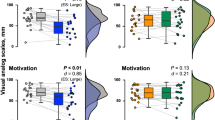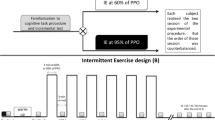Abstract
The purpose of this study was to investigate the effect of two different acute bouts of high-intensity interval training (HIIT) on the Stroop Color Word task and Critical Flicker Fusion (CFF) threshold test. Twenty-five recreationally active subjects (12 men, 13 women; age 23 ± 2.79 years; body mass index 25.03 ± 3.15 kg m−2) were recruited for this study. The acute bouts of HIIT included low-volume (LV) and moderate-volume (MV) sessions. They each had a work to rest ratio of 1:1 min, and exercise was performed at 85% maximal heart rate. The LV session included five intervals, and the MV session included ten intervals. Prior to and after exercise, subjects completed the CFF test and Stroop task. Repeated measures ANOVAs were used to determine the effect of time and volume on test performance. CFF results showed a significant main effect for volume condition across pre/post trials (p = .006), with the MV having a higher average CFF threshold (37.73 ± .63 Hz) compared to LV (36.79 ± .68 Hz). Stroop results showed no main effect of volume condition or interaction (both p > .05) but revealed a significant main effect of time for mean reaction time (RT) total, mean RT congruent/incongruent, and mean RT control (all p < .001). There were no main effects of volume condition or time for proportion correct for all variables (p > .05). The results show that low- and moderate-volume HIIT have similar effects on post-exercise measures of executive function. Our results suggest that the volume of HIIT needed to elicit executive function performance gains may be lower than suggested in previous research.
Similar content being viewed by others
References
Alves, C.R., Gualano, B., Takao, P. P., Avakian, P., Fernandes, R.M., Morine, D., & Takito, M.Y. (2012). Effects of acute physical exercise on executive functions: A comparison between aerobic and strength exercise. J Sport Exerc Psychol, 34(4), 539–549.
Alves, H., Voss, M. W., Boot, R. W., Deslandes, A., Cossich, V., Salles, J. I., & Kramer, A. F. (2013). Perceptual-cognitive expertise in elite volleyball players. Frontiers in Psychology, 4(36), 1–9.
Alves, C. R., Tessaro, V. R., Teixara, L. A., Murakava, K., Roschel, H., Gualano, B., & Takito, M. Y. (2014). Influence of acute high-intensity aerobic interval exercise bout on selective attention and short-term memory tasks. Perceptual & Motor Skills, 118(1), 63–72.
Audiffren, M., Tomporowski, P. D., & Zagrodnik, J. (2009). Acute aerobic exercise and information processing: modulation of executive control in a Random Number Generation task. Acta Psycol, 132(1), 85–95.
Basso, J. C., & Suzuki, W. A. (2017). The effects of acute exercise on mood, cognition, neurophysiology, and neurochemical pathways: a review. Brain Plasticity, 2, 127–152.
Berntson, G. G., & Cacioppo, J. T. (2004). Heart rate variability: stress and psychiatric conditions. Dynamic electrocardiography, 57–64.
Brisswalter, J., Collardeau, M., & Rene, A. (2002). Effects of acute physical exercise characteristics on cognitive performance. Sports Medicine, 32(9), 555–566.
Burgomaster, K. A., Howarth, K. R., Phillips, S. M., Rakobowchuk, M., Macdonald, M. J., McGee, S. L., & Gibala, M. J. (2008). Similar metabolic adaptations during exercise after low volume sprint interval and traditional endurance training in humans. Journal of Physiology, 586(1), 151–160.
Butler, M., Retzlaff, P. D., & Vanderploeg, R. (1991). Neuropsychology test usage. Professional Psychology: Research and Practice, 22(6), 510–512.
Chang, Y. K., Labban, J. D., Gapin, J. I., & Etnier, J. L. (2012). The effects of acute exercise on cognitive performance. Brain Research, 1453, 87–101.
Chang, Y.-K., Chu, C.-H., Wang, C.-C., Wang, Y.-C., Song, T.-F., Tsai, C.-L., & Etnier, J. L. (2015). Does-response relation between exercise duration and cognition. Medicine & Science in Sports & Exercise, 47(1), 159–165.
Cress, M., Porcari, J., & Foster, C. (2015). Health & fitness A to Z. ACSM’s Health & Fitness Journal, 19(6), 3–6.
Curan, S., Hindmarch, I., Wattis, J., & Shillingford, C. (1990). Critical flicker fusion in normal elderly subjects; a cross-sectional community study. Current Psychology, 9, 25–34.
Davranche, K., & Pichon, A. (2005). Critical Flicker Frequency threshold increment after an exhausting exercise. Journal of Sport and Exercise Psychology, 27(4), 515–520.
Fisher, G., Brown, A. W., Bohan Brown, M. M., Alcorn, A., Noles, C., Winwood, L., Resuerhr, H., George, B., Jeansonne, M. M., & Allison, D. B. (2015). High intensity interval- vs moderate intensity-training for improving cardiometabolic health in overweight or obese males: a randomized controlled trial. PLoS One, 10(10), 1–15.
Gallo-Villegas, J., Aristizabal, J. C., Estrada, M., Valbuena, L. H., Narvaez-Sanchez, R., Osorio, J., Aguirre-Acevedo, D. C., & Calderon, J. C. (2018). Efficacy of high-intensity, low-volume interval training compared to continuous aerobic training on insulin resistance, skeletal muscle structure and function in adults with metabolic syndrome: study protocol for a randomized controlled clinical trial. Trials, 19(144), 1–10.
Gibala, M. J., & McGee, S. L. (2008). Metabolic adaptations to short-term high-intensity interval training. Exercise and Sport Sciences Reviews, 36(2), 58–63.
Gibala, M. J., Little, J. P., Macdonald, M. J., & Hawley, J. A. (2012). Physiological adaptations to low-volume, high-intensity interval training in health and disease. Journal of Physiology, 590(5), 1077–1084.
Greer, B. K., Sirithienthad, P., Moffatt, R. J., Marcello, R. T., & Panton, L. B. (2015). EPOC comparison between isocaloric bouts of steady state aerobic, intermittent aerobic, and resistance training. Research Quarterly for Sport and Exercise, 82(2), 190–195.
Guiney, H., & Machado, L. (2013). Benefits of regular aerobic exercise for executive functioning in healthy populations. Psychonomic Bulletin & Review, 20, 73–86.
Hanson, N. J., Short, L. E., Flood, L. T., Cherup, N. P., & Miller, M. G. (2018). Cortical neural arousal is differentially affected by type of physical exercise performed. Experimental Brain Research, 23(6), 1643–1649.
Homack, S., & Riccio, C. A. (2004). A meta-analysis of the sensitivity and specificity of the Stroop Color and Word Test with children. Archives of Clinical Neuropsychology, 19(6), 725–743.
Kao, S.-C., Westfall, D. R., Soneson, J., Gurd, B., & Hillman, C. H. (2017). Comparison of the acute effects of high-intensity interval training and continuous aerobic walking on inhibitory control. Psychophysiology, 54, 1335–1345.
Kao, S.-C., Drollette, E. S., Ritondale, J. P., Khan, N., & Hillman, C. H. (2018). The acute effects of high-intensity interval training and moderate-intensity continuous exercise on declarative memory and inhibitory control. Psychology of Sport & Exercise, 38, 90–99.
Kujach, S., Byun, K., Hyodo, K., Suwabe, K., Fukuie, T., Laskowski, R., Dan, I., & Soya, H. (2018). A transferable high-intensity intermittent exercise improves executive performance in association with dorsolateral prefrontal activation in young adults. NeuroImage, 169, 117–125.
Lambourne, K., & Tomporowski, P. (2010). The effect of exercise-induced arousal on cognitive task performance: a meta-regression analysis. Brain Research, 1341, 12–34.
Lambourne, K., Audiffren, M., & Tomporowski, P. D. (2010). Effects of acute exercise on sensory and executive processing tasks. Medicine and Science in Sports and Exercise, 42(7), 1396–1402.
Ludyga, S., Gerber, M., Brand, S., Holsboer-Trachsler, E., & Pushe, U. (2016). Acute effects of moderate aerobic exercise on specific aspects of executive function in different age and fitness groups: a meta-analysis. Psychophysiology, 53, 1611–1626.
MacInnis, M. J., & Gibala, M. J. (2016). Physiological adaptations to interval training and the role of exercise intensity. Journal of Physiology, 295(5), 2915–2930.
Mewborn, C., Renzi, L., Hammond, B., & Miller, S. (2015). Critical Flicker Fusion predicts executive function in younger and older adults. Archives of Clinical Neuropsychology, 30, 605–610.
McMorris, T, & Hale, B.J. (2012). Differential effects of differing intensities of acute exercise on speed and accuracy of cognition: A meta-analytical investigation. Brain and Cognition, 80, 338–351.
Parkin, C., Kerr, J. S., & Hindmarch, I. (1997). The effect of practice on choice reaction time and critical flicker fusion threshold. Human Psychopharmacology, 12, 65–70.
Prakash, R. S., Voss, M. W., Erickson, K. I., Lewis, J. M., Chaddock, L., Malkowski, E., Alves, H., Kim, J., Szabo, A., White, S. M., Wojcicki, T. R., McAuley, E., & Kramer, A. F. (2011). Cardiorespiratory fitness and attentional control in the aging brain. Frontiers in Human Neuroscience, 4(229), 1–12.
Samuel, R. D., Zavdy, O., Levav, M., Reuveny, R., Katz, U., & Dubnov-Raz, G. (2017). The effects of maximal intensity exercise on cognitive performance in children. Journal of Human Kinetics, 57, 85–96.
Simonson, E., & Brozek, J. (1952). Flicker fusion frequency; background and applications. Physiological Reviews, 32(3), 349–378.
Strauss, E., Sherman, E. M., & Spreen, O. (1991). A compendium of neuropsychological tests: administration, norms, and commentary. Oxford: Oxford University Press.
Stroop, J. R. (1935). Studies of interference in serial verbal reactions. Journal of Experimental Psychology, 18, 643–662.
Tomporowski, P. D. (2003). Effects of acute bouts of exercise on cognition. Acta Psychologica, 112(3), 297–324.
Trapp, E. G., Chisholm, D. J., Freund, J., & Boutcher, S. H. (2008). The effect of high-intensity intermittent exercise training on fat loss and fasting insulin levels of young women. International Journal of Obesity, 32, 684–691.
Tremblay, A., Simoneau, J. A., & Bouchard, C. (1994). Impact of exercise intensity on body fatness and skeletal muscle metabolism. Metabolism, 43(7), 814–818.
Tsukamoto, H., Suga, T., Takenaka, S., Daichi, T., Takeuchi, T., Hamaoka, T., Isaka, T., & Hashimoto, T. (2016). Greater impact of acute high-intensity interval exercise on post-exercise executive function compared to moderate-intensity continuous exercise. Physiology & Behavior, 155, 224–230.
Verburgh, L., Konigs, M., Scherder, E., & Ooserlaan, J. (2014). Physical exercise and executive functions in preadolescent children, adolescents and young adults: a meta-analysis. British Journal of Sports Medicine, 48, 973–979.
Vestburg, T., Reinebo, G., Maurex, L., Ingvar, M., & Petrovic, P. (2017). Core executive functions are associated with success in young elite soccer players. PLoS One, 12(2), 1–13.
Wohlwend, M., Olsen, A., Haberg, A. K., & Palmer, H. S. (2017). Exercise intensity-dependent effects on cognitive control function during and after acute treadmill running in young healthy adults. Frontiers in Psychology, 8(406), 10.
Funding
This study was funded by internal money provided by the Department of Human Performance and Health Education.
Author information
Authors and Affiliations
Corresponding author
Ethics declarations
Conflict of Interest
The authors declare that they have no conflict of interest.
Rights and permissions
About this article
Cite this article
Miller, M.G., Hanson, N., Tennyck, J. et al. A Comparison of High-Intensity Interval Training (HIIT) Volumes on Cognitive Performance. J Cogn Enhanc 3, 168–173 (2019). https://doi.org/10.1007/s41465-018-0107-y
Received:
Accepted:
Published:
Issue Date:
DOI: https://doi.org/10.1007/s41465-018-0107-y




